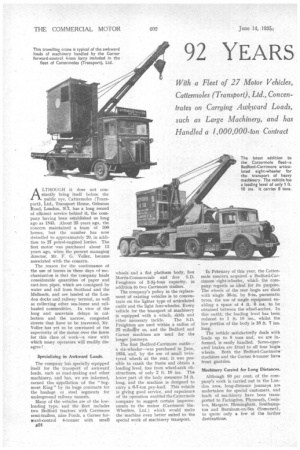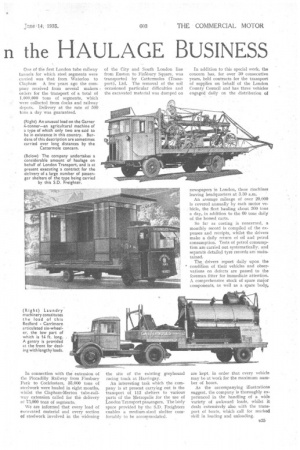92 YEARS n the HAULAGE BUSINESS
Page 34

Page 35

If you've noticed an error in this article please click here to report it so we can fix it.
With a Fleet of 27 Motor Vehicles, Cattermoles (Transport), Ltd., Concentrates on Carrying Awkward Loads, such as Large Machinery, and has Handled a I,000,000-ton Contract
ALTHOUGH it does not constantly bring itself before the nublic eye, Cattermoles (Transport), Ltd., Transport House, Orleston Road, London, N.7, has a long record of efficient service behind it, the company having been established as long ago as 1843. About 25 years ago, the concern maintained a team of 300 horses, but the number has now dwindled to approximately 20, in addition to 27 petrol-engined lorries. The first motor was purchased about 13 years ago, when the present managing director, Mr. F. G. Voller, became associated with the concern.
The reason for the continuance of the use of horses in these days of mechanization is that the company hauls considerable quantities of paper and cast-iron pipes, which are consigned by water and rail from Scotland and the Midlands, and are landed at the London docks and railway termini, as well as collecting other sea-borne and railhauled commodities. In view of the long and uncertain delays in collection and the narrow, congested streets that have to be traversed, Mr. Voller has yet to be convinced of the superiority of the motor over the horse for this class of work—a view with which many operators will readily disagree!
Specializing in Awkward Loads.
The company has specially equipped itself for the transport of awkward loads, such as road-making and other machinery, and has, we are informed, earned theq, appellation of the "Segment King" by its huge contracts for the haulage of steel segments for underground railway tunnels.
Many of the vehicles are of the lowloading type, and the fleet includes two Bedford tractors with Carrimore semi-trailers, nine Fords, a Garner forward-control 4-tanner with small 1124
wheels and a flat platform body, five Morris-Commercials and five S.D. Freighters of 2-3f-tons capacity, in addition to two Carrimore trailers.
The company's policy in the replacement of existing vehicles is to concentrate on the lighter type of articulated outfit and the light four-wheeler. Every vehicle for the transport of machinery is equipped with a winch, skids and other necessary tackle. The S.D. Freighters are used within a radius of 25 miles;Thr so, and the Bedford and Garner machines are used for the longer journeys.
The first Bedford-Carrimore outfit a six-wheeler—was purchased in June, 1934, and, by the use of small twintyred wheels at the rear, it was possible to crank the frame and obtain a loading level, free from wheel-arch obstructions, of only 2 ft. 10 ins. The lower part of the body measures 14 ft. long, and the machine is designed to carry a 8-7-ton pay-load. This vehicle is giving good service, and experience of its operation enabled the Cattermole company to suggest certain improvements to the maker (Carrimore SixWheelers, Ltd.) which would make the machine even better suited to the special work of machinery transport. In February of this year, the Cattermole concern acquired a Bedford-Carrimore eight-wheeler, which the company regards as ideal for its purpose. The wheels of the rear bogie are shod with single 36-in. by 8-in., pneumatic tyres, the use of single equipment enabling a space of 4 ft. 6 ins, to be obtained between the wheel-arches. In this outfit, the loading level has been reduced to 1 ft. 10 ins., whilst the low portion of the body is 18 ft. 7 ins. long.
The vehicle satisfactorily deals with loads up to 8 tons and, we are informed, is easily handled. Servo-operated brakes are fitted to all four bogie wheels. Both the Bedford-Carrimore machines and the Garner 4-tonner have front gantries.
Machinery Carried for Long Distances.
Although SO per cent, of the company's work is carried out in the Landon area, long-distance journeys are undertaken for special customers, and loads of machinery have been transported to Faringdon, Plymouth, Conisten, Margate, Birmingham, Southampton and Burnham-on-Sea (Somerset), to quote only a few of the farther destinations. One of the first London tube railway tunnels for which steel segments were carried was that from Waterloo to Clapham A few years ago the company received from several makers orders for the transport of a total of 1,000,000 tons of segments, which were collected from docks and railway depots. Delivery at the rate of 500 tons a day was. guaranteed.
In connection with the extension of the Piccadilly Railway from Finsbury Park to Cockfosters, 35,000 tons of steelwork were hauled in eight months, whilst the Clapham-Merton tube-railway extension called for the delivery of 73,000 tons of segments.
We are informed that every load of excavated material and every section of steelwork involved in the widening
of the City and South London line from Ruston to Finsbury Square, was transported by Cattermoles (Transport), Ltd. The removal of the soil occasioned particular difficulties and the excavated material was dumped on the site of the existing greyhound racing track at Martin gay.
An interesting task which the company is at present carrying out is the transport of 112 shelters to various parts of the Metropolis for the use of London Transport passengers. The body space provided by the S.D. Freighters enables a rnedium,sized shelter comfortably to be accommodated.
In addition to this special work, the concern has, for over 30 consecutive years, held contracts for the transport of supplies on behalf of the London County Council and has three vehicles engaged daily on the distribution of
newspapers in London, these machines leaving headquarters at 3.30 aan: • '
An average mileage of over 20,000 is covered annually by each motor vehicle, the fleet hauling about 300 tons a day, in addition to the 60 tons daily of the horsed carts.
So far as costing is concerned, a monthly record is compiled of the expenses and receipts, whilst the drivers make a daily return of oil and petrol consumption. Tests of petrol consumption are carried out systematically, and separate detailed tyre records are maintained.
The drivers report daily upon the condition of their vehicles and observations on defects are passed to the foreman. fitter for immediate attention. A comprehensive stock of spare major components, as well as aspare body, are kept, in order that every vehicle may be at -work for the maximum number of hours.
As the accompanying illustrations suggest, the company is thoroughly experienced in the handling of a wide variety of awkward loads, whilst it deals extensively also with the transport of boats, which .call for marked skill in loading and unloading.




















































































